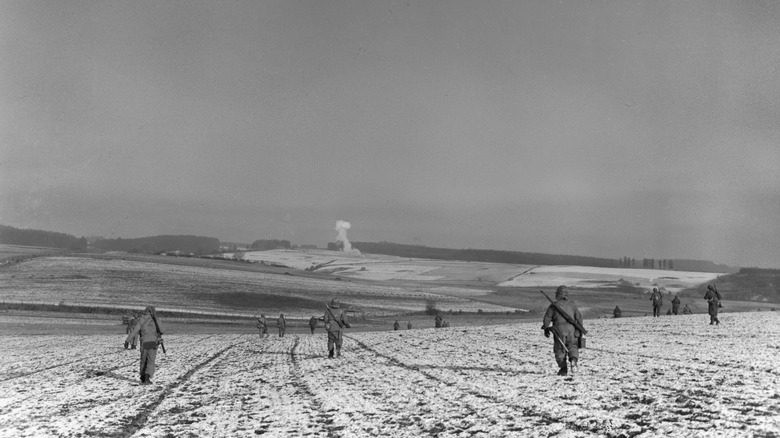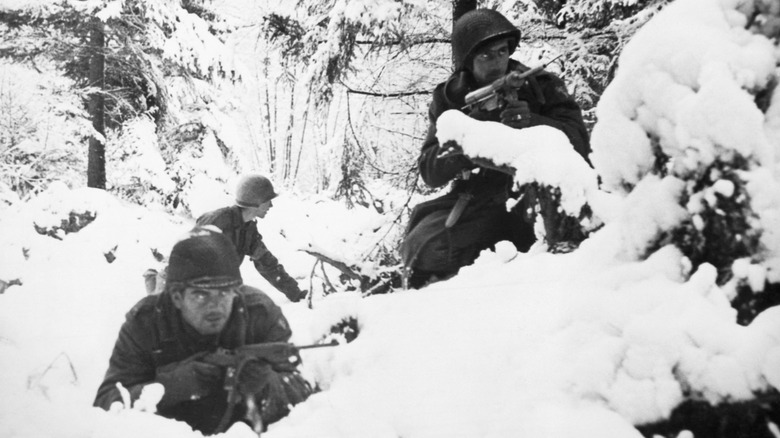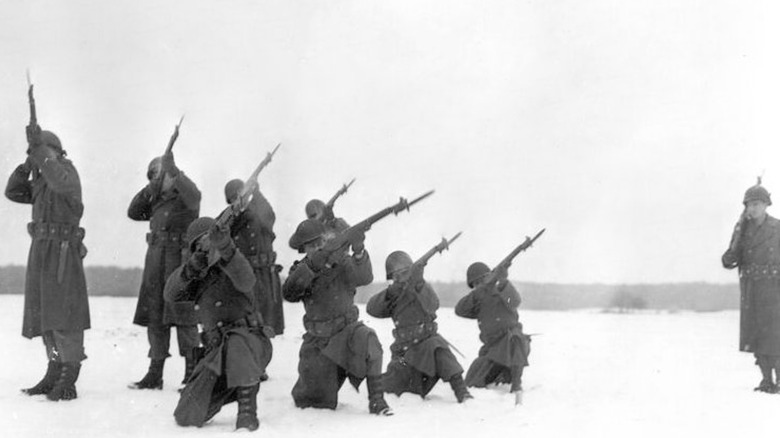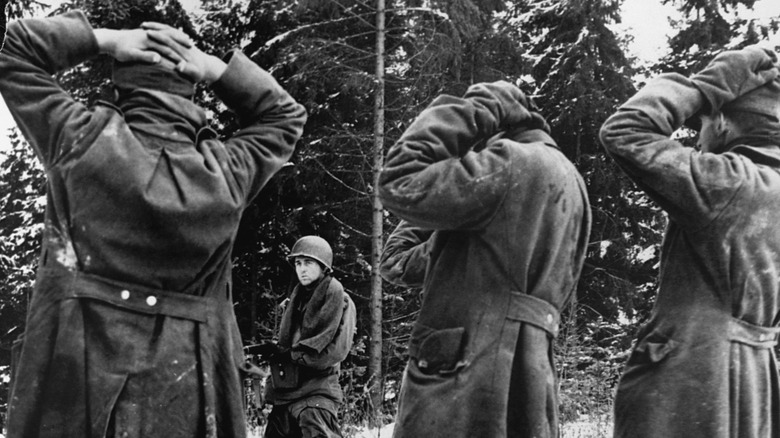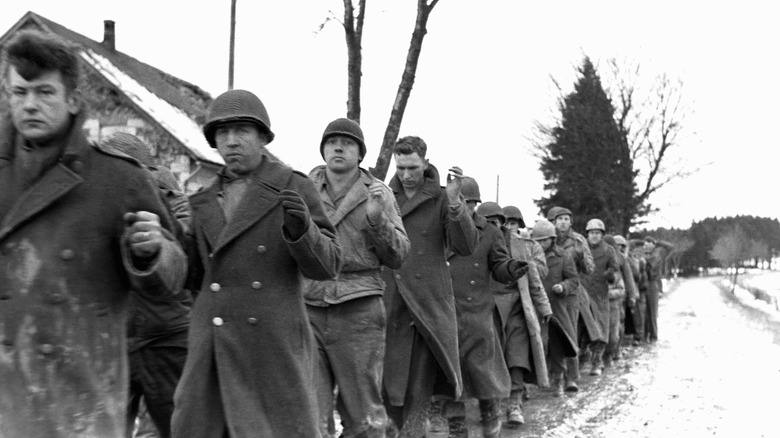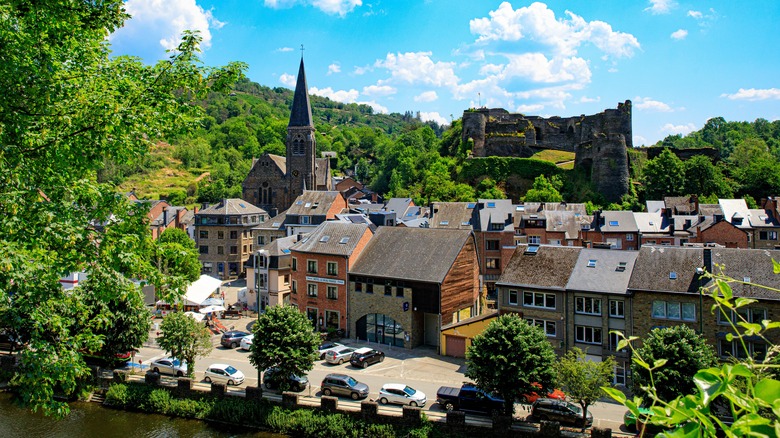What Happened To The Bodies From The Battle Of The Bulge?
At this point, World War II has been endlessly discussed, debated, tread, retread, and condensed into countless historical articles. Big battles with big names stand out in memory, like Dunkirk, Midway, Normandy, and Pearl Harbor. Big, basic facts get cited, like how the Axis forces of Germany, Italy, and Japan fought against the Allied forces of Britain, France, Russia, and later the United States and China. Big numbers get quoted, like how 60 million soldiers died as a result of the conflict. But sometimes the most overlooked details are the most important ones, like where the dead were laid to rest.
In many cases, World War II soldiers who died were buried in temporary graves on the battlefield and later transported to final locations, like at the Battle of Iwo Jima . In naval battles like Midway some of the dead simply vanished into the ocean. And when civilians get caught in conflicts, their remains don't go to military graves. And in the case of the Battle of the Bulge in 1944, those dead who were recovered went to a variety of places.
One million total troops fought in the Battle of the Bulge over five weeks from December 16, 1944 to January 25, 1945. 19,000 U.S. troops died, over 23,000 went missing, and Germany lost a combined 100,000 dead, wounded, or missing. After the battle, dead U.S. soldiers went to one of two Belgian cemeteries, and some of them were repatriated. The German soldiers who died were not repatriated, and currently rest in the German Military Cemetery in Sandweiler, Luxembourg.
Germany's 'Last Gamble' along the western front
Much like World War I, the United States entered World War II late but tipped the scales in favor of Allied powers who in Europe had held against German advances for five years. On June 6, 1944, American, British, and Canadian forces landed on the beaches of Normandy on D-Day, and by the end of August northern France was back in the hands of its people.
Come December, Adolf Hitler-led Germany mounted what the National World War II Museum describes as his "last gamble" in the Ardennes, a region of northeastern France and southeastern Belgium. The Allied line stretched through forested hills, then saturated in snow, for 85 miles across the Belgium-Luxembourg border. After failing to take the Belgian city of Bastogne, the German line bulged inward, hence the "Battle of the Bulge."
Over 1 million troops and thousands of vehicles joined combat that largely saw American forces face off against German forces. In his 2016 book, "My Father's War: Memories from Our Honored WWII Soldiers," Charley Valera describes an anecdote from the battle that sums things up nicely: "Did you ever see land when a tornado's come through? Did you ever see trees and stuff, twisted and broken off? The whole friggin' forest was like that."
Allied forces came out on top in the end. The U.S. Army quotes Winston Churchill as saying, "This is undoubtedly the greatest American battle of the war." It was also the U.S.' most costly in terms of human life.
American cemeteries in Belgium and the U.S.
Exact figures of slain American soldiers at the Battle of the Bulge vary depending on the source. The U.S. Army Center of Military History errs on the high side and says that the U.S. lost 19,000 soldiers, while Liberation Route Europe cites 10,733 soldiers. Estimates of the wounded are closer, with the former site citing 47,500 soldiers and the latter 42,316 soldiers.
All in all, deceased soldiers were interred in two of three U.S. war cemeteries located in Belgium: the Henri-Chapelle American Cemetery located near the intersection of Belgium, the Netherlands, and Germany, and the Ardennes American Cemetery southwest of the Belgian city of Liège. As the WW2 U.S. Medical Research Center says, the majority of the 7,992 American soldiers buried at Henri-Chapelle American Cemetery died during the Battle of the Bulge. The cemetery also contains 94 headstones of unknown soldiers and 450 headstones for missing soldiers. Similarly, many of the 5,328 American soldiers buried at the Ardennes American Cemetery come from the Battle of the Bulge, aside from 792 headstones for unknown soldiers.
For some soldiers, the Henri-Chapelle American Cemetery served as a temporary resting place. As the American Battle Monuments Commission says, 5,600 American soldiers left the cemetery for repatriation in October 1947. While where don't know where every single soldier was finally buried, the U.S. National Park Service explains that some of them were laid to rest at Gettysburg National Cemetery in Pennsylvania.
[Featured image by U.S. Army via Wikimedia Commons | Cropped and scaled]
The German cemetery in Luxembourg
German losses from the Battle of the Bulge were on par with American losses. Liberation Route Europe says that 12,652 German soldiers were killed during the fighting, and 38,600 were wounded. At some point in mid-January German forces ran out of fuel, while all but cemented Germany's loss. By January 25 combat was over. So many vehicles were involved in the fight that both forces lost over 800 tanks — that's about 20 tanks per side every day over 41 days total combat. Germany also lost around 1,000 aircraft.
As Land of Memory cites, 10,913 German soldiers from the Battle of the Bulge were buried at the German Military Center of Sandweiler in Luxembourg, directly south of Luxembourg airport. The cemetery is the first of its kind dedicated to German soldiers outside of Germany and wasn't built until 1955, 10 years after World War II ended. Until then German soldiers from the Battle of the Bulge were interred in what's called the "four corners of Luxembourg," i.e., four regions along the periphery of te country's borders. These regions include the cities of Weiswampach and Troisvierges in the north, Schengen in the south, Born and Wasserbillig in the east, and Pétange in the west. It's unclear where exactly in the four corners these soldiers temporarily rested before being moved to Sandweiler.
POWs, war crimes, and the missing
If we only had to look at soldiers who fell in combat during the Battle of the Bulge, our story would end here. However, the Battle of conflict saw savagery and inhumanity beyond that typically exhibited during wartime. Adolf Hitler didn't simply strike with desperation at the Allied lines in the Ardennes with whatever remained of German might — he told his troops to do so without "human inhibitions," as Stars and Stripes quotes. "The enemy must be beaten now or never!," he raved, "whether we live or die."
Under such guidance German soldiers slaughtered American POWs, killed unarmed American troops who'd surrendered at the Malmedy Massacre, and even brutally tortured soldiers at the Wereth 11 Massacre. While we can't account for the dead from each of these kinds of instances, doubtlessly they help comprise the 23,000 missing U.S. soldiers from the Battle of Bulge — that's more than the dead we've recovered. The remains of these individuals might still lay precisely where they fell, buried forever under the dirt.
What's come to be known as the Wereth 11 Massacre stands out from the rest if only for the truly shocking, animalistic treatment of U.S. troops by German troops. As Warfare History Network recounts, one soldier had four fingers pulled directly off his hand. Others had so many bones broken that they wouldn't have been able to crawl. Another was bayoneted in the eye. Many were crushed by vehicles. These soldiers were found when the slow melted about two months after they died.
The fate of Belgian civilians and soldiers
Lest we forget the most innocent victims of the Battle of the Bulge, we've got to talk about the civilians who died in the conflict. Liberation Route Europe says that about 2,500 Belgian civilians and 500 Luxembourgish civilians died over the battle's five weeks. HistoryNet says that these 2,500 Belgians accounted for a greater number of dead Belgian civilians than the entire war until then.
The Belgian site Battle of the Bulge describes German troops storming through the Belgian hamlets of Parfondruy, Ster, and Renardmont and shooting pleading women who held babies, firing on people who ran away, shooting people who refused to cooperate, burning down barns where people hid, and so forth. It's unclear exactly how many Belgians died in this fashion, just as it's unclear what happened to their bodies. As Land of Memory explains, other Belgian cities like La Roche-en-Ardenn were flattened and hundreds of residents killed.
Finally, the Defense Visual Information Distribution Service describes Belgian soldiers joining the American forces during the Battle of the Bulge. "The resistance was really active in Belgium," Belgian veteran Marcel D'Haese said. "We were doing sabotage to the Germans, like cutting the communications lines." While we don't know exactly how many Belgians partook in the Battle of the Bulge, we know that 53,000 men joined the Allied forces following the Battle of Normandy. Some of these individuals fought and died, were presumably recovered, and perhaps went missing, at the Battle of the Bulge.
